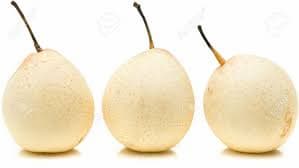Without doubt, in the world of madcap artists and composers, Erik Satie was the most eccentric. Just how eccentric was he? In 1893, he conceived a piece entitled Vexations. The piece consists of a single bass phrase to be accompanied with chords notated above it.

Erik Satie
According to Satie, “In order to play the theme 840 times in succession, it would be advisable to prepare oneself beforehand, and in the deepest silence, through serious immobility.” He founded his own religion, based on the “Mystical Order of the Rose and Cross of the Temple and Grail,” and wherever he walked, he carried around a large hammer for protection. He spent some time in jail, only wore grey suits, and kept to a meticulous daily schedule.

3 Chinese white pears
In his Memoirs of an Amnesiac of 1912, he writes “I rise at 7:18; am inspired from 10:23 to 11:47. I lunch at 12:11 and leave the table at 12:14. A healthy ride on horseback round my domain follows from 1:19 P.M. to 2:53 P.M. Another bout of inspiration takes hold from 3:12 to 4:07 P.M. From 4:27 to 6:47 P.M. I engage with various occupations, including fencing, reflection, immobility, visits, contemplation, dexterity, and swimming. Dinner is served at 7:16 and finished at 7:20 P.M. From 8:09 to 9:59 P.M. I read out loud. I go to bed regularly at 10:37 P.M. Once a week, I wake up with a start at 3:19 (Tuesdays).”
Erik Satie: Trois Morceaux en Forme de Poire (Three Pieces in the Shape of a Pear)
And if you think that all this is a bit eccentric, have a look at his bizarre diet! “My only nourishment,” he writes, “consists of food that is white: eggs, sugar, grated bones, the fat of dead animals, veal, salt, coconuts, chicken cooked in white water, fruit-mold, rice, turnips, camphorated sausages, pastry, cheese (white varieties), cotton salad, and certain kinds of fish (without their skin). I boil my wine and drink it cold mixed with the juice of the Fuchsia. I am a hearty eater but never speak while eating for fear of choking.” Of course, there is no way of knowing if Satie actually kept to that particular diet or whether he was a closet eater. In the event, his seeming food eccentricity also finds its way into his music. I suppose a “Chinese White Pear,” if Satie would have actually known that fruit, would easily fall in the category of “white food.”
For more of the best in classical music, sign up for our E-Newsletter

